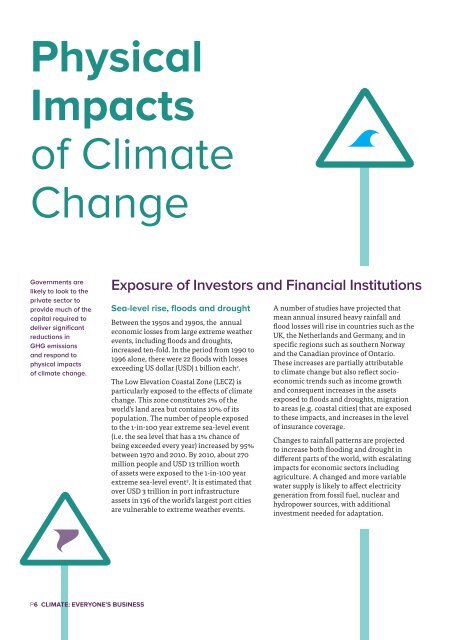IPCC_AR5__Implications_for_Investors__Briefing__WEB_EN
IPCC_AR5__Implications_for_Investors__Briefing__WEB_EN
IPCC_AR5__Implications_for_Investors__Briefing__WEB_EN
Create successful ePaper yourself
Turn your PDF publications into a flip-book with our unique Google optimized e-Paper software.
PhysicalImpactsof ClimateChangeGovernments arelikely to look to theprivate sector toprovide much of thecapital required todeliver significantreductions inGHG emissionsand respond tophysical impactsof climate change.Exposure of <strong>Investors</strong> and Financial InstitutionsSea-level rise, floods and droughtBetween the 1950s and 1990s, the annualeconomic losses from large extreme weatherevents, including floods and droughts,increased ten-fold. In the period from 1990 to1996 alone, there were 22 floods with lossesexceeding US dollar (USD) 1 billion each 2 .The Low Elevation Coastal Zone (LECZ) isparticularly exposed to the effects of climatechange. This zone constitutes 2% of theworld’s land area but contains 10% of itspopulation. The number of people exposedto the 1-in-100 year extreme sea-level event(i.e. the sea level that has a 1% chance ofbeing exceeded every year) increased by 95%between 1970 and 2010. By 2010, about 270million people and USD 13 trillion worthof assets were exposed to the 1-in-100 yearextreme sea-level event 3 . It is estimated thatover USD 3 trillion in port infrastructureassets in 136 of the world’s largest port citiesare vulnerable to extreme weather events.A number of studies have projected thatmean annual insured heavy rainfall andflood losses will rise in countries such as theUK, the Netherlands and Germany, and inspecific regions such as southern Norwayand the Canadian province of Ontario.These increases are partially attributableto climate change but also reflect socioeconomictrends such as income growthand consequent increases in the assetsexposed to floods and droughts, migrationto areas (e.g. coastal cities) that are exposedto these impacts, and increases in the levelof insurance coverage.Changes to rainfall patterns are projectedto increase both flooding and drought indifferent parts of the world, with escalatingimpacts <strong>for</strong> economic sectors includingagriculture. A changed and more variablewater supply is likely to affect electricitygeneration from fossil fuel, nuclear andhydropower sources, with additionalinvestment needed <strong>for</strong> adaptation.P6 Climate: Everyone's Business



